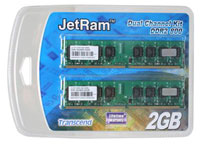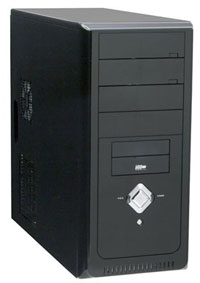AMD Gaming Platform
When we leave the budget sector behind and start looking at midrange configurations, the amount of customization that can be done becomes far more significant. We basically doubled our budget, but that doesn't mean you actually have to spend anywhere near $1500 to get a reasonable midrange configuration. It should be quite easy to cut back a few areas in order to get the price closer to $1000, if that's the target budget. For the AMD platform, we decided to focus on putting together a good gaming solution.
| AMD Gaming System |
| Hardware |
Component |
Price |
Rebates |
| Processor |
Athlon 64 X2 4800+ (Windsor 2.5GHz 2x512K) - Retail |
$133 |
|
| Motherboard |
EVGA 122-M2-NF59-TR (Socket AM2 nForce 590 SLI) |
$136 |
$30 |
| Memory |
Transcend JETRAM 2x1GB DDR2-800 (5-5-5-12 JM2GDDR2-8K) |
$113 |
|
| Video Card |
Foxconn GeForce 8800GTS 640MB (FV-N88SMBD2-ONOC) |
$400 |
$40 |
| Hard Drive |
Seagate Barracuda 7200.10 ST3320620AS 320GB 16MB |
$80 |
|
| Optical Drive |
Pioneer Black DVR-112D 18X DVD+R |
$38 |
|
| Case |
Athenatech A5719BB.500 with 500W PSU |
$106 |
$20 |
| Display |
Acer AL2216Wbd 22" 5ms (1680x1050) |
$274 |
|
| Speakers |
Logitech X-530 5.1 70W Speakers |
$74 |
|
| Keyboard and Mouse |
Microsoft Comfort Curve 2000 B2L-00047 |
$28 |
|
| Operating System |
Windows MCE 2005 or Vista Home Premium (OEM) |
$115 |
|
| Bottom Line |
|
$1497 |
$1407 |
 |
CPU performance can still be a factor in many games, particularly RTS games where lots of units might be in action at the same time, but graphics horsepower is still far more important in the majority of titles. We made a moderate upgrade to the processor selection, going with the Athlon X2 4800+. That should offer more than enough power for any current games, and it leaves us plenty of money to spend on the GPU. Overclocking is always an option, although most AMD AM2 processors seem to top out in the range of 2.6-2.8GHz so we would either go with a less expensive CPU for overclocking purposes or else simply spend the extra money in order to get a guaranteed minimum performance. If you want something faster than a 4800+ and you don't want to move to Core 2 Duo, the 5400+ is worth a serious look. Priced at $200, that processor comes with 1MB of L2 cache per core and a default clock speed of 2.8GHz - basically what used to be the $1000 FX-62. Just don't expect it to greatly improve your gaming performance except at lower resolutions/detail settings.
 |
For the motherboard, looking at prices we decided the ability to support dual X16 PCI-E slots was a reasonable addition, as the price isn't much higher than the dual X8 PCI-E alternatives. The nForce 590 SLI chipset has been well-regarded since its launch last year, and prices on such boards have dropped substantially. This also gives us the option to move up to SLI graphics cards in the future to improve performance, and while that tends to be beyond the realm of midrange computers it's not inconceivable that some people will want to spend a couple hundred dollars a year from now to improve performance. Taking a look at the current 590 SLI motherboard offerings, EVGA comes out on top with some of the best features while maintaining the lowest price - under $100 after rebate! The EVGA motherboard is actually the same reference design as the Foxconn nForce 590 SLI board that garnered our Silver Editors' Choice award last year, right down to the inclusion of FireWire 1394b support, and it costs $35 less than the Foxconn board before rebates.
 |
As we mentioned, the graphics card is going to be the primary concern in just about any gaming system. Right now, without blowing our budget by moving up to the 8800 GTX, the GeForce 8800 GTS is the most reasonable solution. Having settled on that chip, you then need to decide whether you want to get the more expensive 640MB version or stick with the basic 320MB offering. There are several games out that are using a lot of textures, which can start taxing 512MB cards, so opting for the larger memory version seems to make the most sense in terms of serious gaming. It's also a lot easier to find factory overclocked cards in the 640MB models without paying too much of a price premium. The Foxconn 8800 GTS comes clocked at 575/1800 (stock is 500/1600) and after rebates it ties several other cards as being the cheapest 8800 GTS 640MB. Lowest priced card with higher factory clock speeds? We'll take it, especially considering all of the GeForce 8800 cards use the same NVIDIA supplied circuit board, so the only real differences will be factory clock speeds, warranty/support, and potentially modified cooling solutions. XFX and EVGA may come with better warranty policies, but Foxconn certainly isn't a bad company to deal with in our experience.
Before you rush out and purchase this particular graphics card, however, it is worth noting that AMD's new Radeon X2900 XT/XTX cards are scheduled to launch in the next month. The rumors have it that these cards will offer performance better than the 8800 GTX at prices starting around $400 for the XT model. Whether or not the availability and drivers are going to be up to snuff is a complete unknown - NVIDIA is still working on G80 driver issues, particularly in regards to Windows Vista, and we don't have any DirectX 10 enabled games yet - but it certainly wouldn't hurt to wait another month and see what happens. Should you choose to get one of the new AMD graphics cards, you might also want to skip the EVGA SLI board and pick up an ASUS M2R32-MVP 580X CrossFire enabled motherboard instead.
 |
For the memory, this time we did upgrade to 2GB of RAM. We didn't bother with anything fancy - 5-5-5-12 memory is only a few percent slower than 4-4-4-12 memory and costs quite a bit less - and again we are quite pleased to see that memory prices have dropped a long way since the beginning of the year. Transcend JETRAM is one of the many memory providers that offers "average" performance. If you're looking to set speed or overclocking records, you could certainly spend more money and get RAM that is capable of running at much higher clock speeds with better timings, but for the cost you would be far better off spending the extra money on a faster graphics card or processor first. We generally only recommend exotic memory solutions for the high-end market.
 |
Most of the remaining components have received minor upgrades relative to our entry level configurations. The hard drive is slightly larger, we chose 5.1 speakers, and we selected a different case with a "more powerful" power supply. The power supply probably isn't all that great, but if you aren't going to push your system with overclocking, multiple graphics cards, or a bunch of hard drives the 500W PSU included with the Athenatech case will work fine.
 |
The display once again presented us with a dilemma: do we want to go with a higher quality offering or do we want a larger display? In reality, most of the 22" and smaller LCDs tend to have fewer features and lower quality. For example, TN panels are standard on every 22" LCD we've seen so far, and they are also used on most of the other smaller displays. It's possible to find S-PVA panels on some of the 20" displays, but you will end up paying more than the 22" Acer that we selected. The AL2216W is a decent quality display, and the price makes it particularly attractive. Acer also has a newer and slightly less expensive AL2223W offering, although that is a 6-bit panel that approximates 16.2 million colors via dithering whereas the AL2216W is an 8-bit panel.
















46 Comments
View All Comments
xsilver - Monday, April 23, 2007 - link
A quick mention of the possible headroom on the 2x1gb Jetram would have been nice?eg. does it overclock to cas 4? or does it OC to ddr900? or both? or none?
amking0 - Saturday, April 21, 2007 - link
with all the recent price cuts and rebates floating around, i've finally decided to leave my single core a64 system behind and do an upgrade to something along the following lines:e6600
650i board (probably)
2 gb corsair ddr2-800
old 7800 gt for the time being
just wanted to comment about the x-fi issues you mentioned in the article tho (since i just ordered one on sale + a $50 rebate) ...you have me worried now D:
i'm also pondering the move to vista, but i guess i might be sticking with xp a little longer now.
yyrkoon - Monday, April 23, 2007 - link
Why not just use onboard Audio ? I find it hard to belive that anyone could tell the difference between onboard, and descrete audio. regardless, I have had my last several system, all with onboard audio, and dropped in the random audio card, only difference I could tell, was about 3-5FPS in Oblivion, other than that, no difference.FrankM - Saturday, April 21, 2007 - link
"We tossed around several brands, including SeaSonic and Silverstone, but in the end we selected the Corsair 520W."Actually, that Corsair is a rebranded SeaSonic...
If only reliability and stability is the issue for the PSU for overclocking, there are cheaper quality PSUs available; the real strenght of the Seasonic/Corsair is the high efficiency and very low noise.
JarredWalton - Saturday, April 21, 2007 - link
I actually did know that (that it's a rebranded SeaSonic), but didn't think it was necessary to go into the details. Basically, I was looking at some PSUs in the range of $100 shipped, and figured at that point the extra $15 was money well spent to get a very high quality PSU. The SeaSonic model was $15 more than the Corsair, IIRC, so no reason to pay more for the same PSU.yyrkoon - Monday, April 23, 2007 - link
The Antec EA500W earthwatts PSU can be had for less than $50 usd(after rebate), and had a very favorable review from JonnyGuru. I use one myself, but I am not exactly using it harshly (midly OC'd Opteron 1210, and a 7600GT, 7 HDDs, and an optical). Seems fine so far, but is only about 3-4months old.deathwalker - Saturday, April 21, 2007 - link
Good grief, since when did a $400 video card fit in the catagory of a Mid-range product? Im going to have to research past guides for mid=range systems to see if AT has just completely broken the mold.JarredWalton - Saturday, April 21, 2007 - link
It specifically is targeting the gaming market. As mentioned, the 8800 GTS 320 is a $120 cheaper option that you might consider. For games, though, the GPU is the bottleneck 95% of the time, so you should get as much GPU power as possible.Ronson - Friday, June 8, 2007 - link
If a $400 Graphics card is gaming then what are the cheaper cards for? Office use? A $200 Graphics card would have been more reasonable. The $400 card really just belongs in the High End guide.yyrkoon - Saturday, April 21, 2007 - link
AMD Athlon 64 X2 3600+ Brisbane - $72.00
ABIT NF-M2 nView - $94.99
CORSAIR XMS2 2x1GB DDR2 800 - $122.00
Seagate Barracuda 250GB - $67.99
Total - $356.98
Migrate optical drive, Case, PSU, Keyboard, mouse, and monitor from old system, because if you're reading here, you have a computer already, OR, you are using a friends PC, in which case you need to buy a Dell. All parts are free shipping, from newegg.
I have to say, I must question your choise of motherboard for the 'budget'/ entry level AMD system. It has been my experience, that anything this inexpencive from ASUS, or ASROCK, is nothing but a piece of junk, with very little driver / BIOS support, if any at all. Not to say the ABIT board I have chosen has had much driver / BIOS support, but it is rock solid, and has many features that put other boards a class or two above to shame. Anyhow . . . </fanboyism>